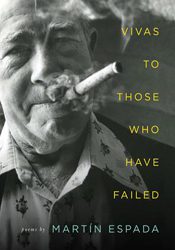
Vivas to Those Who Have Failed, Martín Espada’s new collection of poetry is both an homage to—and a lament for—the victims of various calamities. The book’s title echoes a line from Whitman’s Leaves of Grass, the prototypic poetic narrative that celebrates the struggles of everyday people.
Espada is no stranger to struggle. A first-generation American from a Puerto Rican family, Espada channels the immigrant experience. He revives stories of Latino—as well as Italian, Irish and Jewish—immigrants of the 1930s. He writes of contemporary issues, as well: acts of violence from killings to natural disasters. This is a book about communities—of the poor, the helpless, and the working class.
The collection’s first poem, “Vivas to Those Who Have Failed: Paterson Silk Strike of 1913,” chronicles a labor strike in which three-thousand textile workers were arrested in New Jersey. The strike was led by Italians and other immigrant factory workers who manufactured bright-red ties. The poem tells of an innocent bystander killed by police, an all-too-familiar occurrence today. The poet acknowledges that these workers, these early labor activists, were defeated; but their campaign led to the eight-hour day and other improvements.
The stories in this book are told in verse, poetry, elegy, and praise. We hear America singing again, singing the dirges of lives interrupted by violence and war, poverty and other injustices. Espada’s narrative harnesses themes seen in some of the most powerful American writing today. Like others of his generation, including Rankine, Hacker, Eady, and Olds, Espada is part of a great wave of poets who bear witness. These writers carry messages that awaken us to the transgressions that took place in the name of making America “great”; through their poetry, we see how these transgressions affect us today.
Espada is a professor at University of Massachusetts, Amherst. His writing communicates the ethos of contemporary student protest, with its spotlight on Confederate symbols, campus rape, and buildings named after tyrants, for example. In this vein of activism, the poem, “The Right Foot of Juan de Oñate” opens our eyes to the historic title character’s foul practice of maiming every Acoma Pueblo male over the age of twenty-five by cutting off his right foot. Oñate was a real-life Spanish conquistador; Espada’s poem conjures the real-life bronze statue of the conquistador, which stands in Alcalde, New Mexico. Espada also conjures the reallife event of Native Americans sawing off the bronze Oñate’s right foot in 1998. By referencing this act of defiance, the poet renders the oppressor helpless, trapped in old, dead ways, with a “spirit scratching and howling like a dog within the bronze body.” Oñate’s spirit is neutralized, while the spirit of the Acoma Pueblo lives on. Those who have failed, live.
The atrocities described in Espada’s work are not limited to the violence of centuries past. The poems in this volume also open a fresh wound when Espada evokes current-day tragedies. “Heal the Cracks in the Bell of the World,” about the Newtown shootings, breaks into chant with the lines:
“melt the bullets into bells. melt the bullets into bells.”
and
“melt the cannons into bells. melt the cannons into bells.”
Nothing can soothe the collective pain of mass shootings, our distinctly American disaster. But Espada’s use of anaphora and imagery creates a calming, albeit at times numbing, effect. One can only think of the cracks in Philadelphia’s Liberty Bell when Espada writes:
“The chimes heal the cracks in the bell of the moon.
The chimes heal the cracks in the bell of the world.”
Layered with symbolism, this poem leads us on a search for the meaning of freedom in the aftermath of violence. The poem offers no solutions; rather, its incantation leaves us somewhere between a prayer and a lament. Espada’s poems act as a salve for today’s violence, just as Whitman’s poems dress the wounds of the Civil War.
“Ghazal for a Tall Boy from New Hampshire” traces the life of Jim Foley, the American foreign-affairs journalist who was decapitated by ISIS in 2014. (Espada was Foley’s teacher at Amherst.) Here, the poet uses the poetic form of the Arabic ghazal to comfort the reader; Espada adapts the ghazal’s structure, with its couplets and refrain, to express pain and mourning. The poet replaces our horror with words that convey the bittersweet beauty that we reach for when we cannot bear what we’ve lost.
Espada’s tribute to Foley sings his praises; it tells of Foley’s desire to teach, to help others. These qualities are what Espada, his teacher, saw in him. The poem also refers to what the poet is deliberately unwilling to witness: actual video of his student’s death. The poet tells us about feeling offended when the press, seeking more sensationalism, asked if he had in fact seen “the video his killers wanted us to see.” This is a poem about not only a tragic murder, but about what the media and politicians make of such events.
A repeated line in the poem questions whether anyone really knew Foley, this young man, this teacher who lost his life so prematurely, until the poet reaches the ambivalent conclusion, “I knew him. I never knew him.” It is as if to say that we can know nothing in this day and age, that, in this violent universe, no understanding is allowed to come to fruition before it is destroyed.
 What shines through in this book is the purity of those who live in earnest. Espada celebrates local heroes, including Cheguí, the boxer from Lexington Avenue and 110th street whose successes in the ring were the pride of the Puerto Ricans, especially when Cheguí became the first Latino to win the light-heavyweight championship in 1965. Cheguí ultimately lost his title (Viva to Those who Have Failed!), yet he put New York’s Puerto Ricans on the map. Espada empowers Cheguí as a symbol of the continued, complicated, colonial relationship between the US and Puerto Rico.
What shines through in this book is the purity of those who live in earnest. Espada celebrates local heroes, including Cheguí, the boxer from Lexington Avenue and 110th street whose successes in the ring were the pride of the Puerto Ricans, especially when Cheguí became the first Latino to win the light-heavyweight championship in 1965. Cheguí ultimately lost his title (Viva to Those who Have Failed!), yet he put New York’s Puerto Ricans on the map. Espada empowers Cheguí as a symbol of the continued, complicated, colonial relationship between the US and Puerto Rico.
Espada lifts the voices of those struggling to attain equal rights and opportunities within the framework of American democracy. Several poems are dedicated to some of the people of color who have been killed by police: Michael Brown, Trayvon Martin, Eric Garner, John T. Williams, Martín Tito Pérez.
The final section of the book is dedicated to Frank Espada, the poet’s father, who died in 2014. Entitled “El Moriviví,” this section’s eponymous poem is named for the plant, native to Puerto Rico which shrinks when touched. All of the poems in this section continue to explore the notion that spirits can be revived after death and those who have failed can still live. Frank Espada was a civil-rights activist and a strong role model for his son. Martín Espada’s work continues the earnest activism of his father. This poet’s work breathes life into those who failed—the downtrodden, the forgotten, and the dead—so that their voices may speak to us now.




